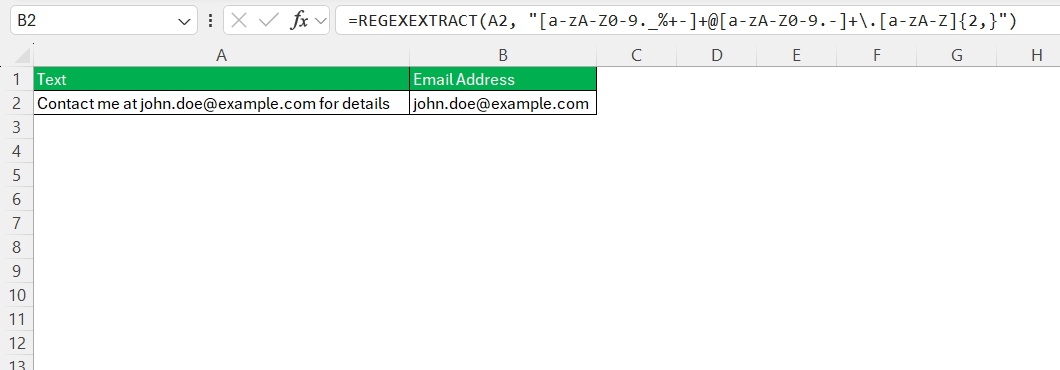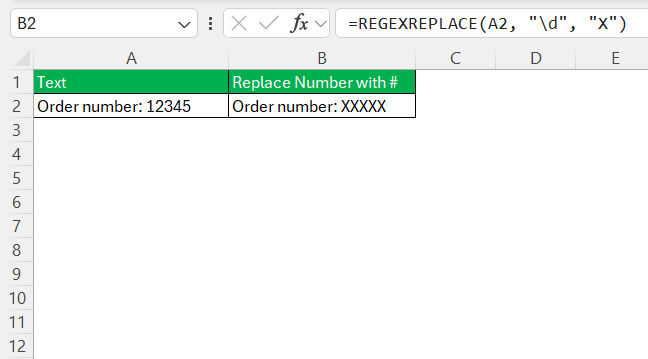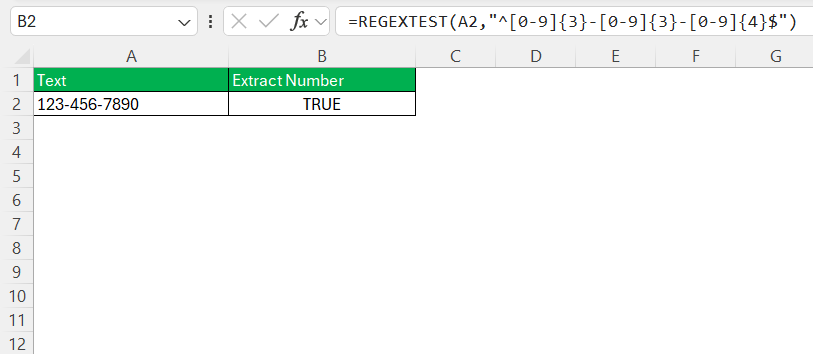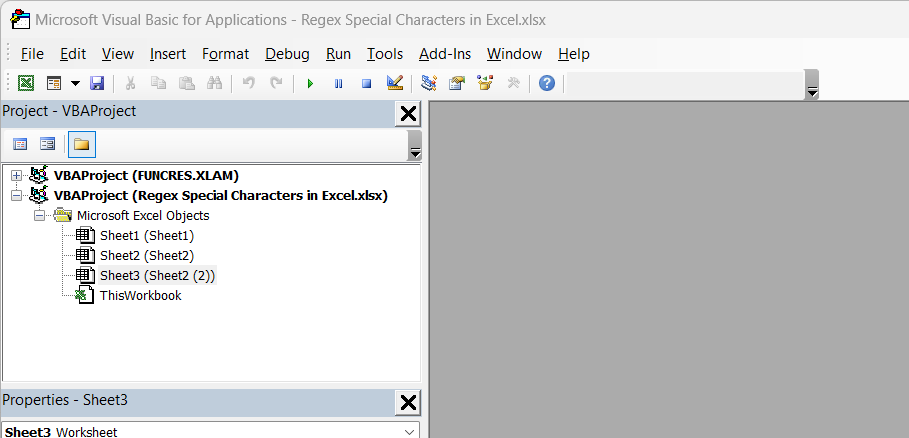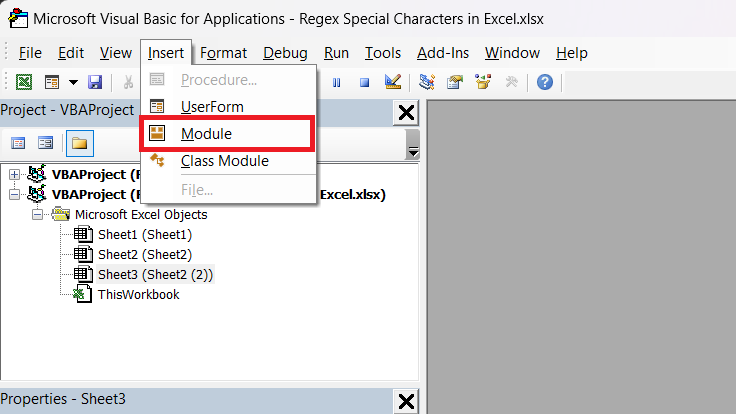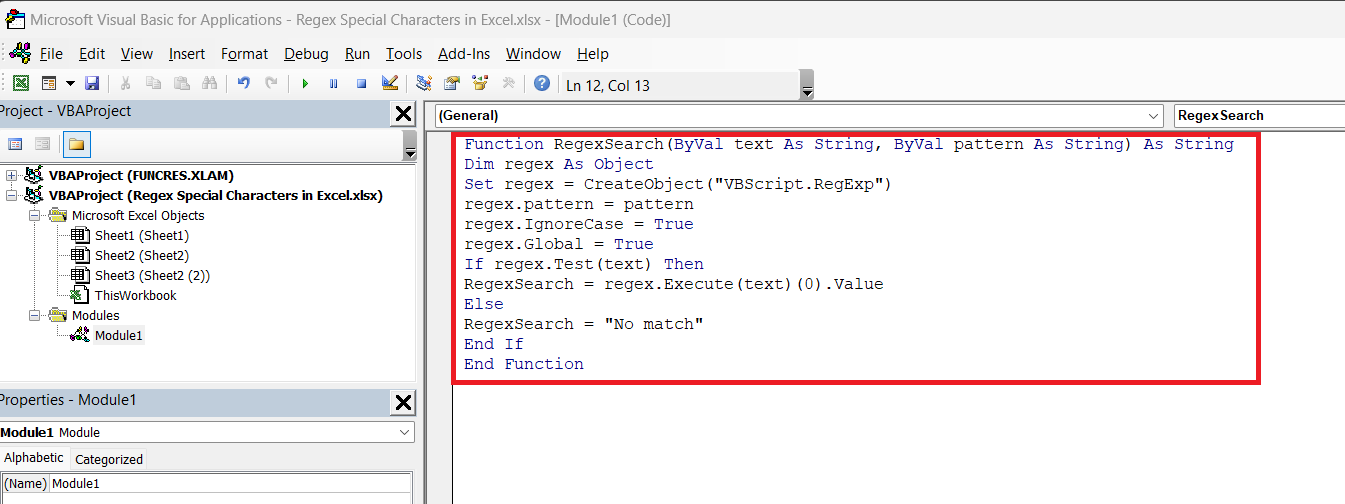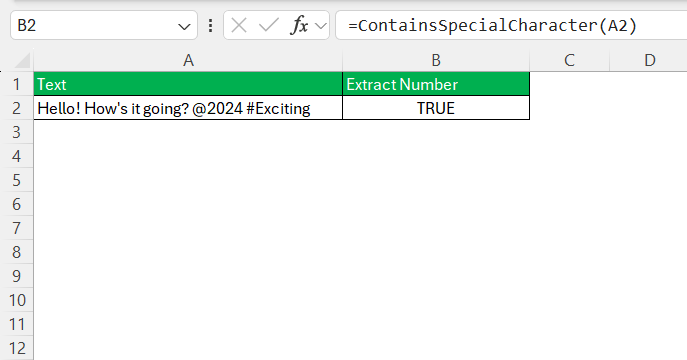Working with data in Excel often requires cleaning and transforming text, and regular expressions (regex) are a powerful tool for handling complex text manipulations. If you work with large datasets and need to extract or modify specific text patterns, mastering regex can be a game changer—starting with understanding its special characters.
In this guide, I’ll cover these special characters, how they work, and how you can apply them in Excel using VBA, with practical examples to streamline your data tasks.
Key Takeaways:
- Powerful Text Manipulation: Regular expressions (regex) provide a powerful way to identify and manipulate text patterns, making it easier to manage data in Excel.
- Applications in Data Management: Regex is crucial for tasks like data cleaning, complex searches, and data validation, helping to streamline data accuracy and consistency.
- Common Special Characters: Understanding regex special characters (like
.,*,+, and?) enhances the ability to create flexible and precise search patterns. - Excel Functions: Excel includes specific functions for regex, such as
REGEXEXTRACT,REGEXREPLACE, andREGEXMATCH, which simplify data manipulation tasks. - VBA Integration: By using VBA, I can leverage regex capabilities even when Excel formulas do not directly support them, expanding the potential for data analysis.
Table of Contents
Unraveling the Power of Regex in Excel
Understanding the Basics of Regular Expressions
As we delve into the capabilities of Excel, we uncover the significant role that regular expressions play in managing and manipulating text. At their core, regular expressions are a pattern-matching standard that allows for the identification and manipulation of specific text within a string.
Think of these patterns as a search language, intricate yet precise, capable of sifting through swathes of text to find the sequences that matter to us.
Key Applications for Regex in Excel Data Management
In the realm of data management within Excel, Regex emerges as an indispensable ally. It aids in various tasks such as data cleansing by pinpointing unwanted characters or formatting inconsistencies. Let’s talk about a few applications:
Data Cleaning: Regex simplifies the arduous task of scrubbing data for accuracy. Suppose we want to remove all the special characters from text entries to maintain a consistent format – Regex patterns are perfect for this.
Complex Searches: Picture working with a massive dataset where finding specific patterns, like email addresses or URLs, is akin to searching for a needle in a haystack. Here, Regex makes the search effortless with its sophisticated pattern-matching abilities.
Data Validation: Before diving into analysis, ensuring that data adheres to desired formats is crucial. Regex comes to the rescue by validating formats, such as confirming that phone numbers or social security numbers conform to standard patterns.
By harnessing the power of Regex within Excel, we truly streamline our workflow to a remarkable degree.
Introduction to Regex in Excel
What Are Regex Special Characters?
Regular expressions are all about patterns, and these patterns are built using both literal characters (the text you’re looking for) and special characters. These special characters, also known as metacharacters, have specific meanings that allow you to construct more flexible and powerful search criteria.
Let’s break down some of the most commonly used regex special characters:
- Dot (.) – The dot is one of the most frequently used special characters in regex. It matches any single character except for a newline. The pattern
a.cwould match “abc”, “a3c”, or “a-c” but not “ac” or “abcc”. - Asterisk (*) – The asterisk is used to match zero or more occurrences of the preceding character or group.
ca*twould match “ct”, “cat”, “caaaat”, and any other variation with “a” repeated any number of times. - Plus Sign (+) – Similar to the asterisk, but the plus sign matches one or more occurrences of the preceding character or group.
ca+twould match “cat”, “caaaat”, but not “ct”. - Question Mark (?) – The question mark indicates that the preceding character or group is optional, meaning it will match either zero or one occurrence.
colou?rwould match both “color” and “colour”. - Caret (^) – The caret is used to match the start of a line or string.
^abcwould match “abc” at the beginning of a string but not “zabc”. - Dollar Sign ($) – The dollar sign is used to match the end of a line or string.
xyz$would match “xyz” at the end of a string but not “xyzabc”. - Square Brackets ([ ]) – Square brackets are used to specify a set of characters, allowing a match for any one character within the brackets.
[aeiou]would match any single vowel in a string. - Pipe (|) – The pipe character is used to indicate a logical OR. It allows you to match one pattern or another.
cat|dogwould match either “cat” or “dog”. - Backslash () – The backslash is used to escape special characters, making them literal instead of functional in the regex pattern.
\$100would match the literal string “$100” instead of interpreting the dollar sign as the end of a line. - Curly Braces ({ }) – Curly braces are used to specify the number of occurrences of the preceding character or group.
a{3}would match “aaa” but not “aa” or “aaaa”. - Parentheses (( )) – Parentheses are used to group characters or patterns, allowing you to apply quantifiers like
*,+, or?to the entire group.(abc)+would match “abc”, “abcabc”, and so on. - Hyphen (-) – Inside square brackets, a hyphen specifies a range of characters.
[a-z]would match any lowercase letter.
Example of Excel Regex Functions
Excel has embraced the versatility of Regex by incorporating it into its formidable array of functions. Here are the key players in the Excel Regex toolkit:
REGEXEXTRACT
This function is your go-to when you need to pull specific patterns from text. For example, extracting email addresses from a paragraph is a cakewalk with REGEXEXTRACT.
If I have a cell (A2) that contains: “Contact me at [email protected] for details”. I can use REGEXEXTRACT to extract the email address:
=REGEXEXTRACT(A2, “[a-zA-Z0-9._%+-]+@[a-zA-Z0-9.-]+\.[a-zA-Z]{2,}”)
This formula looks for a valid email format and pulls out [email protected] from the text.
REGEXREPLACE
Suppose there’s a common typo in your spreadsheet or you want to replace specific characters or words; REGEXREPLACE makes it possible with just a few keystrokes.
Let’s say A2 contains: “Order number: 12345”. To replace the numbers with X’s, I’d use:
=REGEXREPLACE(A2, “\d”, “X”)
This formula swaps out every digit (\d) with “X”, resulting in: Order number: XXXXX.
REGEXMATCH
When it’s imperative to know whether a particular pattern exists within a text, REGEXMATCH will confirm its presence without actually extracting or replacing anything.
If A2 contains: “Call me at 123-456-7890″. To see if there’s a phone number in that format (like XXX-XXX-XXXX), I use:
=REGEXTEST(A2,”^[0-9]{3}-[0-9]{3}-[0-9]{4}$”)
This formula returns TRUE if the text has a phone number in the 123-456-7890 format.
These functions open a world of possibilities, making tedious tasks that used to take countless hours now manageable in moments.
Using VBA in Excel
While Excel doesn’t directly support regex in its formulas, I’ve found that using VBA (Visual Basic for Applications) is a great workaround. I’ll walk you through how you can implement regex in Excel using VBA to take full advantage of regex special characters.
STEP 1: Press Alt + F11 to open the VBA editor in Excel.
STEP 2: In the VBA editor, go to Insert > Module.
STEP 3: Now that we’ve set everything up, here’s a simple example of how you can use regex in Excel. This function searches for a pattern within a string:
Function ContainsSpecialCharacter(ByVal text As String) As Boolean
Dim regex As Object
Set regex = CreateObject("VBScript.RegExp")
regex.Pattern = "[!@#$%^&*(),.?;:<>[\]{}|\\]" ' Define the pattern for special characters
regex.IgnoreCase = True
regex.Global = True
ContainsSpecialCharacter = regex.Test(text) ' Check if the text contains special characters
End Function
This function returns “TRUE” if there is any special character in the text and “FALSE” otherwise.
Problem-Solving Typical RegEx Challenges in Excel
In the trenches of Excel data manipulation, various challenges can arise when applying RegEx. The trick is to navigate these with savvy problem-solving tactics:
- Non-Matching Patterns: If a RegEx isn’t yielding results, break the pattern down and test in parts. Verify each segment against sample data to identify where it fails.
- Performance Issues: Be mindful of performance when applying RegEx to large datasets. Optimize by minimizing the use of wildcard characters and ensuring the pattern is as specific as possible.
- Handling Null Values: Ensure that your RegEx functions can gracefully handle empty cells or unexpected input to avoid runtime errors in VBA.
By troubleshooting issues systematically, we cultivate a strategy that turns the tide in our favor, making RegEx a reliable tool in Excel’s arsenal.
Real-World Examples and Best Practices
Case Studies: How Professionals Leverage Excel Regex
Professionals across the spectrum have harnessed the power of Excel Regex for transformative outcomes. Here are a couple of case studies:
Marketing Data Alignment: A marketing analyst utilized Regex to standardize and cleanse a database with thousands of customer records. By crafting patterns to correct common misspellings and uniform naming conventions, the data became more reliable for segmentation and targeting.
Financial Reporting Efficiency: An accountant implemented Regex UDFs to automate the extraction and formatting of financial data from various text reports. This reduced the time for monthly report compilation by over 50%, allowing the team to focus on analysis rather than manual data entry.
These real-world examples showcase the tremendous efficiency and accuracy gains that can be achieved with Excel Regex, spotlighting its potential across myriad professions and industries.
From Novice to Pro: Developing Your Excel Regex Skillset
Advancing from a beginner to a proficient user of Regex in Excel is a journey that involves a blend of learning and practical application. Here’s my blueprint to upskill:
- Start with the Basics: Grasp the foundational syntax of Regex, such as understanding wildcards, character classes, and quantifiers.
- Apply as You Learn: Practice by tackling real-world data problems you encounter in Excel. This reinforces concepts and reveals the practical utility of your growing skills.
- Challenge Yourself: As you get comfortable with simpler patterns, challenge yourself with complex tasks such as nested expressions or lookahead assertions.
- Document and Reflect: Keep notes on the challenges you solve. These reflections serve as a valuable resource for future tasks and contribute to your continuous learning process.
By iterating through these steps, we develop a robust skill set that not only makes us proficient with Regex in Excel but also enhances our overall approach to problem-solving within the platform.
FAQ – Mastering Regex in Excel
What is regex in Excel?
Regex, or regular expressions, in Excel is a powerful tool for pattern matching and text manipulation. It allows me to define search patterns to extract, replace, or validate specific sequences of characters within text strings. With functions like REGEXEXTRACT, REGEXREPLACE, and REGEXTEST, I can efficiently clean data and perform complex searches. Additionally, using VBA enhances my ability to implement advanced regex functionalities, streamlining data management in Excel.
How do I get Excel to recognize special characters?
To have Excel recognize special characters, you’ll need to use either the Find and Replace function (Ctrl + F or Ctrl + H) with specific character codes or employ Regex through VBA for pattern matching. For instance, use ~ to search for special characters like * or ?. If incorporating RegEx, use functions like REGEXEXTRACT, REGEXREPLACE, and REGEXTEST.
Can you provide an example of a formula that finds special characters?
Certainly! An example formula using Excel functions to find if cell A1 contains any special characters might look like this:
=SUMPRODUCT(--ISNUMBER(SEARCH({"!","@","#","$","%","^","&","*","(",")","-","+"}, A1)))>0
This formula checks for common special characters in cell A1 and returns TRUE if any are present; otherwise, it returns FALSE. However, for comprehensive searches, using RegEx with VBA would yield much more versatile results.
How do I ensure that my Regex formulas are efficient and error-free?
To ensure your RegEx formulas are both efficient and error-free, always start by clearly defining the pattern you need to match. Test your formula with various sample data to catch unexpected behavior. Use online RegEx testers to refine patterns before applying them in Excel, and consider adding error handling if using VBA. Finally, review and document your RegEx for maintainability.
Can I use regex in Excel formulas?
Yes, functions like REGEXEXTRACT, REGEXREPLACE, and REGEXMATCH allow for regex usage directly in Excel formulas.
John Michaloudis is a former accountant and finance analyst at General Electric, a Microsoft MVP since 2020, an Amazon #1 bestselling author of 4 Microsoft Excel books and teacher of Microsoft Excel & Office over at his flagship MyExcelOnline Academy Online Course.

